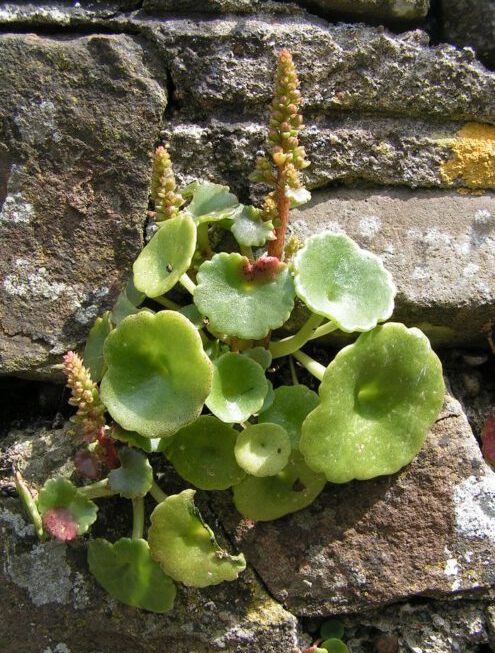Researchers estimate age of star dune called Lala Lallia, Morocco
The post The secret of Earth’s incredible moving star sand dunes appeared first on Green Prophet.
In my foraging walks during late winter and spring, I’m always glad to find Navelwort (Umbelicus rupestris). It’s a fleshy, light-green plant often rooted in damp old walls and piles of rocks. Navelwort, also known as pennywort, is becoming rare.
I collect a few of the juicy leaves for use in my moisturizing formula, where they’ll add soothing, anti-inflammatory properties. Is navelwort edible? Yes, and if by chance I come across a place where navelwort grows abundantly, I’ll bring a few more leaves home to eat raw in salad – to be honest, more because I enjoy the experience than because of their flavor, which is mild and neutral.
For the hungry forager, we have a post about a tastier, more easily found wild edible: beet greens.
The seventeenth-century herbalist Nicholas Culpepper knew and appreciated navelwort, saying this of it:
The juice or the distilled water being drank, is very effectual for all inflammations and unnatural heats, to cool a fainting hot stomach, a hot liver, or the bowels: the herb, juice, or distilled water thereof, outwardly applied, heals pimples, St. Anthony’s fire, and other outward heats. The said juice or water helps to heal sore kidneys, torn or fretted by the stone, or exulcerated within; it also provokes urine, is available for the dropsy, and helps to break the stone. Being used as a bath, or made into an ointment, it cools the painful piles or hæmorrhoidal veins. It is no less effectual to give ease to the pains of the gout, the sciatica, and helps the kernels or knots in the neck or throat, called the king’s evil: healing kibes (ulcerated chilblains) and chilblains if they be bathed with the juice, or anointed with ointment made thereof, and some of the skin of the leaf upon them: it is also used in green wounds to stay the blood, and to heal them quickly.
According to the Plants For A Future Plant Database (PFAF), navelwort can be found in leaf all year, in flower from June to August. The seeds ripen from July to September. The species is hermaphrodite (has both male and female organs) and is self-fertile. The flowers turn red if the plant grows in a sunny spot.
Keep in mind that PFAF’s articles concern plants growing in the UK and Europe, not often mentioning growing conditions in the Levant. In Israel, where I live, navelwort has dried up and disappeared by July.
If you’re intrigued enough to try cultivating Navelwort, it’s (again, via the PFAF database) suitable for light (sandy) and medium (loamy) soils and prefers well-drained soil. Suitable pH: mildly acid, neutral and basic (mildly alkaline) soils. It can grow in semi-shade (light woodland) or no shade. It prefers moist soil.
I myself don’t think of cultivating navelwort; it’s too dry and hot where I live. But when I lived in the cool north of the country, where there are still many uncultivated green spots and ancient, fallen-down stone houses, I’d love to find the round leaves, that look like a collection of belly-buttons, poking up from some old wall. Those ancient Romans had a knack for naming things: umbilicus meaning navel, and rupestris, of the wall.
Or you can imagine that a long-ago someone poked a finger into the leaves to leave a dimple in the middle.
I cherish navelwort not only for the uses I put it to, but because of its growing rarity. The places that favor its growth are fast disappearing under urban construction.
It recalls a much earlier time, when a kindlier climate allowed these innocent herbs to thrive undisturbed, and humans in their foraging took only what they needed and left the rest alone.
Recommended Story For You :

Bringing Dead Batteries Back To Life Is Simple!

SEPTIFIX to the Rescue! Say Goodbye to Problems and Hello to Savings

Ecomposing of Paper Towels Produce Methane Gas

A Leading Cause Of Global Warming!

A cleaner world where energy is abundant essentially free

and sourced directly out of the inherent power of the space surrounding us.

MIT Discovery can cut power bills by 65%

Easy DIY Power Plan Will Change Our World Forever

Discover the World with Our Passionate Geography Teacher in Memphis!


